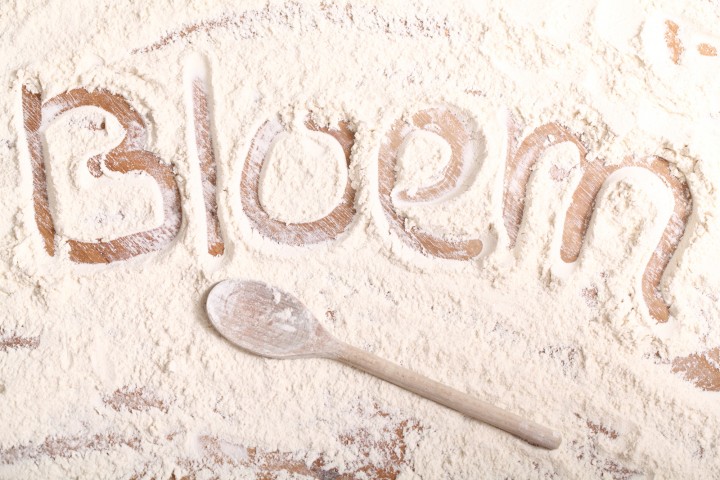
Flour quality and type are the essence of good bread. It all begins with buying the right kind for your recipe!
Getting good quality flour is the easiest way to improve the way your bread will look and taste. Flour from supermarkets tends to be very white, often old, lacking in taste and natural enzymes, and, most important, not very useful for bread baking (at least over here in Holland).
We get our flour from a windmill, which gets its wheat from the center of The Netherlands. They then grind it on big stones, powered by wind. The flour has an EKO (organic) seal of approval, a very nice yellowish hue from the natural carotene and it tastes of fresh grass and wheat berries. The flour is so fresh we have to ‘store’ it for 2 weeks to improve the baking properties and water absorption ability.
We are very lucky to have found great bread flour so close to home. How much difference it makes is also shown in our flour experiment for which we baked the same loaf with both high quality flour from a mill and cheap supermarket flour.
This flour overview teaches you more about flour types and how they are referred to in different countries. It can help you buy the right type of flour, no matter what country you bake in.
| Ash | Protein | US | German | French | Italian | Netherlands |
|---|---|---|---|---|---|---|
| ~ 0.4% | ~ 9% | pastry flour | 405 | 45 | 00 | zeeuwse bloem |
| ~ 0.55% | ~ 11% | all-purpose flour | 550 | 55 | 0 | patentbloem |
| ~ 0.8% | ~ 14% | high gluten flour | 812 | 80 | 1 | tarwebloem |
| ~ 1% | ~ 15% | first clear flour | 1050 | 110 | 2 | gebuilde bloem |
| > 1.5% | ~ 13% | whole wheat flour | 1700 | 150 | Farina integrale | volkorenmeel |
Ash content explained
To establish the ash content of flour a fixed amount of the flour is burned and what is left after this process is the ‘ash’. The amount that is left is expressed as a percentage of the original fixed amount. The ash consist of minerals that are left after burning, so they do not combust.
It is a way of determining the quality / purity of the flour. A higher ash content indicates that the flour contains more of the germ, bran, and outer endosperm. Lower ash content indicates that the flour is more refined. As you can see in the table above, the whole wheat flour has the highest ash content.
German flour type numbers (Mehltypen) indicate the amount of ash (unburned mineral content, measured in milligrams) obtained from 100 g of the dry mass of this flour. Standard wheat flours range from type 405 for normal white wheat flour for baking, to strong bread flour types 550, 812, and the darker types 1050 and 1700 for wholegrain breads. There is also a type 1600 which fits between white wheat flour and whole wheat flour, it will give you a darker white bread.
French flour type numbers indicate the ash content (in milligrams) per 10 g flour. The numbers are a factor 10 lower than the German types. Type 55 is the standard, hard-wheat white flour for baking, including puff pastries (“pâte feuilletée”). Type 45 is often called pastry flour, and is generally from a softer wheat (this corresponds to what older French texts call “farine de gruau”). Some recipes use Type 45 for croissants although many French bakers use Type 55 or a combination of Types 45 and 55. Types 65, 80, and 110 are strong bread flours of increasing darkness, and type 150 is a wholemeal flour. Note that there is no type 40 French flour like the German type 405, the closest is type 45.
In the United States and the United Kingdom, no numbered standardized flour types are defined, and the ash mass is only rarely given on the label by flour manufacturers. However, the legally required standard nutrition label specifies the protein content of the flour, which is also a way for comparing the extraction rates of different available flour types.
British flour types for bread baking:
Stoneground strong wholemeal* 100% extraction rate* – 12-14% protein
Stoneground wholemeal 95% extraction rate – 12-14% protein
Strong white extraction rate 72-75% – 12 to 13% protein
Extra strong white extraction rate 72-75% – 14 to 15% protein
Plain white 72-75% extraction rate – 9 to 11% protein (can be use to replace Italian 00 flour for example, but less suitable for most bread baking and most often used for cakes and cookies / biscuits)
Brown 80% extraction rate – 12-14% protein
*Extraction rate: The amount of original grain left in the flour. These extraction rates are not often mentioned on the bags. To make white flour you sift out germ and bran. If you sift out all the germ and bran it’s about 28% and you end up with 72% extraction flour.
*We often use the term wholewheat (like in America) but it means the same as the UK term wholemeal, but wholemeal can also refer to other grains like wholemeal spelt flour. In Holland we call this ‘volkoren’.
In the Netherlands it is even harder to establish the protein content and ash mass as most bags simply state ‘Tarwebloem’ or ‘Patentbloem’. As a general rule all flour, both ‘Tarwebloem’ and ‘Patentbloem’, you can buy in supermarkets have a low protein content and will not bake great bread. We have found out, by baking and experimenting a lot, that most ‘Tarwebloem’ flours sold by windmills in The Netherlands work well for baking artisan breads.
Soft wheat with lower protein content and less gluten is used for pastry. Hard wheat with higher protein content and more gluten is used for bread.
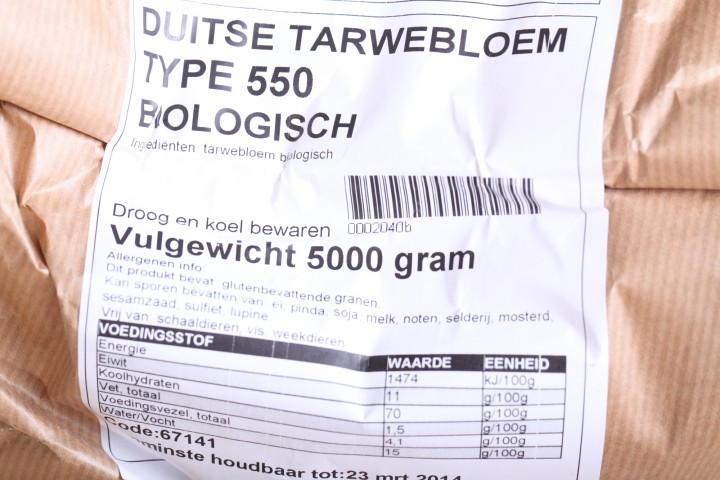
In general, as the extraction rate of the flour increases, so do both the protein and the ash content. However, as the extraction rate approaches 100% (whole meal), the protein content drops slightly, while the ash content continues to rise. Apart from the extraction rate itself the wheat can be of the soft or hard type. Hard wheat (usually hard spring wheat) has a higher gluten content (between 11% and 13%) and is excellent for baking bread. Soft wheat has a lower gluten content (between 9% and 11%) and is often used in all purpose flour and pastry flour which gives a more crumbly texture. Soft flour is usually divided into cake flour, which is the lowest in gluten, and pastry flour, which has slightly more gluten than cake flour. To make things even more complex, you can make whole wheat flour from soft wheat and patent flour from hard wheat and vice versa.
The English word for “flour” is originally a variant of the word “flower”. Both derive from the Old French fleur or flour, which had the literal meaning “blossom,” and a figurative meaning “the finest.” The phrase “fleur de farine” meant “the finest part of the meal,” since flour resulted from the elimination of coarse and unwanted matter from the grain during milling.
‘Dutch’ flour glossary
| Flour | Description |
|---|---|
| 00 bloem | Very fine Italian flour made of hard- or soft wheat. |
| Amerikaanse patent | A high protein content wheat flour, so very high in gluten. Found in Dutch bakeries under the name ‘lely’. |
| Bread flour | Usually to indicate a high protein content wheat flour (around 13%), so very high in gluten. |
| Durum | Triticum Durum, a wheat type with high protein content growing in warm areas. The germ has a yellow hue. Often used for Italian pasta. |
| Franse bloem | Very fine flour of only the germ and the endosperm. Often used for French baguettes. |
| Gebuilde bloem | Fine flour with only a part of the bran (usually has an extraction of 80% and 85%). |
| Grano Tenero | Soft wheat, low in gluten. Available in different extractions. |
| Grano Duro | Hard wheat, high in gluten. Available in different extractions. |
| Griesmeel | Coarse ground grains, for example wheat, spelt, corn or rice. |
| Kiem | Germ, the seed for a new plant, contains B vitamins, some protein, minerals and healthy oils. |
| Manitoba | A Canadian high protein content wheat flour, so very high in gluten. |
| Meellichaam / Meelkern | Endosperm, contains starch, protein, some vitamins and minerals. This is the food source for the germ to grow into a new plant. |
| Patentbloem | Very fine wheat flour without germ and bran. There is a big difference in quality between brands. |
| Patisserie bloem | Zeeuwse bloem or pastry flour. Very finy white flour with a low gluten content. |
| Semolina | Coarse ground grains, often from durum wheat. |
| Semolina rimacinata | Fine ground grains, often from durum wheat. |
| Tarwebloem | Fine ground wheat. Whiteness is between ‘patentbloem’ and ‘tarwemeel’. |
| Tarwemeel | A blend of ½ bread flour, ½ whole wheat, used in ‘tarwebrood’. |
| Volkorenmeel | The coarse ground complete wheat grain, contains the whole kernel, used for ‘volkorenbrood’. |
| Zachte bloem | Triticum Sativum, soft wheat flour with low to medium protein / gluten content. |
| Zeeuwse bloem | Fine flour with low gluten content, used for cookies and pastry. |
| Zemel | Bran, protective outer shell. High in fiber and B vitamins. |



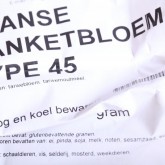
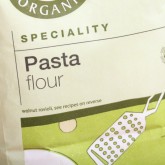
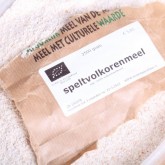
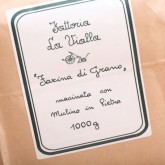
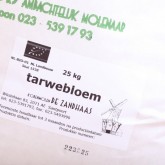
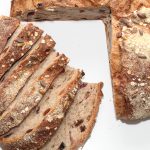

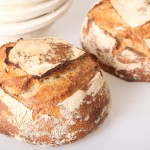
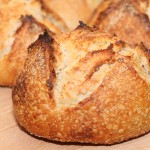
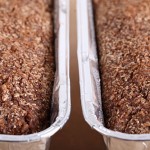

Ronita says
I would like a suggestion of what’s the best bread flour to use.
Weekend Bakers says
Hello Ronita,
It depends on where you live, but our experience is that the stone ground organic wheat flour with a protein content of around 12.5% is very good for bread baking. We use it for our rustic loaves but also for baguettes and as a base together with other types of flour like rye and spelt.
Rose Lowenberg says
Im new at making pasta which flour would be best used. Recipe called for 100% flour. Im in Arizona if that plays a part in which flour to use.
Weekend Bakers says
Hello Rose,
You have several options: The best are semolina made of durum wheat or Italian typo ’00’ flour. In general you want a pasta with low elasticity but with a good gluten content (the right gluten). It is best to look for the information on the bag or with the product that says the flour is especially suited for making pasta. See : www.mulinocaputo.it/en/fl…-e-gnocchi
If you do not have these options, you can also try and make pasta with all purpose / plain flour. The result will not be as good, but you will have fresh pasta!
Erica Moody says
Hello! I have just been given some flour from De Zuidmolen and I could do with some help.
One is 100%wholemeal as I understand. The label says TARWEmeel. Also Gebuild Tarwemeel/Lemairemeel. I have recently been trying 100% wholemeal sourdough loaves so it will be fun to try this flour!
The other is Meel voor zacht maisebrood and has lots of ingredients. I recognise wheat,extruded maize,sunflower seeds,wheat gluten,palm oil?, plus flour improver, etc etc.
What would I use this for?
Weekend Bakers says
Hi Erica,
The tarwemeel is usually a little less whole wheat / meal than the 100% wholemeal you already used. So it will be good for your sourdough loaf too, maybe even a little less compact in result.
The other ‘meel’ seems to be a ‘ready for use’ bread-mix with bread baking enhancers to get a good baking result, even though maize has no gluten for instance. So you will probably only need to add water and follow instructions on the bag to make a loaf out of it.
To be honest, we never use these bread-mixes, because of the added ingredients we do not want in our bread (like the palm oil).
Enjoy your baking and experimenting with the flour.
Marieke
Yaaol says
I used to buy the Shipton Mill Canadian strong white bread flour (112), but I want to switch to their organic white flour No.4 (known also as 105). The protein percentage in the first is 12.1% while the other is 11.3%. I’m using this for my sourdough. My concern is mainly with the rise being effected. My gut feeling is telling me it won’t matter that much in the summer (well it’s London summers) but I might have to increase the percentage of the starter by 5% to compensate during the winter. Alternatively, I can add about 3% wheat germ to boost the protein. Or am I splitting hairs? What are your thoughts?
Weekend Bakers says
Hello Yaaol,
What we have learned is that you do not know until you try your first loaf with a fresh sack of flour. Next to protein % there’s also the type of gluten, the quality of the wheat to consider. Every time we need to make adjustments, that’s just the way it is, also from season to season. Our suggestion would be to make a loaf with just the new flour and see where you stand. Then make one with the added germ. With your favorite recipes you will always know what the dough should look and feel like.
Enjoy your baking!
Altamash Shaikh says
Which German flour type will you relate to Indian chapati flour? Indian wheat flour?
Weekend Bakers says
Hello Altamash,
This is not our field of expertise but we would guess the Indian wheat flour would probably correspond with the German 812 or 1050 type.
Laila says
There is a misconception about Italian flour. The numbers 00, 1, etc has to to with the grind of the flour and nothing to do with protein content. Double 00 is a finely ground flour but the protein content is not low or similar to pastry flour.
In fact most Italian 00 flours are excellent for pizza and have and have a protein content around 12% more or less depending on brand.
Weekend Bakers says
Thank you so much Laila, it is really important we explain this better in the post too! We will add this explanation to the above.
Enjoy your baking and all the best to you and your wonderful country and people!
Ed & Marieke
WKB
Giuseppe says
Very nice post. Can you please tell me what is in the Nal the most close to the bread string flour ? Amerikaanae patentblowm?
Thanks
Weekend Bakers says
We have a bit of difficulty to understand your question, we think auto correct plays a part in this…
Giuseppe says
Ops, sorry. It was fault of my iPhone wrong language setting.
I was asking about what is the flour in NL that is the closest to the strong bread flour (about 13% in protein, high gluten) usually use to bake bread.
Regards
Giuseppe
Giuseppe says
I forgot to say…. this website is so great!!!
I have just got to know it now.
Cheers
Weekend Bakers says
And thank you very much / Bedankt!
Weekend Bakers says
Hi again Giuseppe,
When baking bread in Holland you need to look for ‘tarwebloem’ and look on the package for the % of protein (you will usually not find 13 but 12% will be possible). We have the best results with organic tarwebloem, also for the taste of the bread. We also buy strong Italian flour from Caputo here in Holland (see shop.italieplein.nl/produ…no-caputo/) or durum flour which you can also combined with the tarwebloem if you want to make a ‘stronger’ flour if needed. Our favorite tarwebloem comes from the windmill in Santpoort near Haarlem called ‘De Zandhaas’.
Hope you will find good flour to bake your bread.
Giuseppe says
Bedankt voor de hulp 🙂
I am baking with the organic tarwebloem 12% from my local windmill.
Fantastic taste but difficult to go for high hydrations and large holes in the bread.
I know Caputo of course. Thank you for the tips on where to find it.
And what about patent tarwebloem? Is this all purpose flour?
Weekend Bakers says
Hello Giuseppe,
The patentbloem is usually used for cookies and cakes, not for bread baking. Generally speaking, (also depending on the protein content), it is comparable to all purpose flour.
Kathy says
I bought a Italian type 1 flour but it labeled as soft wheat. I used it to bake sourdough, it didn’t rise much.
My starter is 10% rye flour & 90% bread flour.
I also used the type 1 flour to bake sponge bread (like a mini baguette) and the result is a disaster.
Please advance.
Weekend Bakers says
Hello Kathy,
You need to look for ‘strong flour’ with a protein content of 12 to 13% if possible. Look at the flour you bought and the protein content, it is probably lower, but also the type of gluten play a key roll in the end result.
This flour you have now is probably not able to build a strong gluten-network. Next to this it could also be that your sourdough culture is not yet strong and mature enough, Make sure to keep feeding and refreshing and using it and it will get better too.
May we suggest you buy a good bread flour and trying our pain naturel recipe and see how that goes!
www.weekendbakery.com/posts…n-naturel/
Kathy says
Thank you very much. I’ll try your recipe 🙂
Weekend Bakers says
Let us know how it goes!
Vivian says
Hi
I live in the Netherlands and have been having problems where to find good flour.
I just started my sourdough starter using stoneground rye that I purchased from the UK. Is this a good flour to use for my starter? I an not getting a very good rise from my starter (it’s 6th days in).
Thank you
Weekend Bakers says
Hi Vivian,
Yes, we think that is a right type of flour to use. The organic quality works best is our experience, because you will have the best change of finding ‘live yeast’ in it. We know we are not spoiled for choice at the moment with finding the right products. The first thing you could try is giving your starter culture a few good extra stirs two or three times a day, to get some extra oxygen in there and see if it makes a difference. Otherwise, if possible, see if you can buy a bag of organic whole rye (volkoren roggemeel) in a store that sells organic food.
Online you could buy it here: www.pit-pit.com/roggemeel.html
This is a shop we also buy our spices and other stuff from and are really happy with.
Itziar says
This is so helpful! I love baking bread and have had a one year long nightmare trying to figure out Dutch flours and fighting the curse of finding only low gluten white flour in the supermarket (can find good wholegrain stuff for bread but not white). I’m used to the English and Spanish styles where they just clearly label “strong” flour for high gluten flours which makes it super easy. Here? Not so much!
Weekend Bakers says
Hello Itziar,
We completely understand what you mean. That is why we always encourage people to go and visit a mill. These days that can be a bit of a challenge, but depending on where you live, there can still be possibilities.
It is also possible to buy online. De Zuidmolen has lots of choice in flour and a few days ago their web shop was open but now it has closed again due to too much demand. But maybe for another time it would be something to consider. We also buy Italian flour (Caputo) for our pizza and flatbread and here: shop.italieplein.nl/produ…pizzameel/ which works great.
Let us know if we can help you with anything Dutch and baking related that is still unclear!
Itamar Ronen says
Dear Ed and Marieke,
I enormously enjoy your website, recipes and tips! two basic questions:
1. I have made a starter made of 50% volkoren tarwemeel and 50% tarwebloem, both biologisch. It would consistently triple in volume 4-5 hours after feeding. I have recently got a big batch of tarwebloem voor brood from a different source (also bio), and I currently use it for my starter instead of the previous tarwebloem. The started consistently grow less – just about double the size after about 3-4 hours. Results are still pretty good, but I wonder if you have experience with variability of starter activity and tips/suggestions for the panicky beginner baker…
2. I’m quite confused regarding the use of meel vs. bloem in breads. For example – I want to start using rye, but I’m not sure what’s a better choice for a good sourdough rye bread – roggemeel or roggebloem?
Alvast bedankt!
groeten – –
Itamar
Weekend Bakers says
Thank you very much Itamar,
We would indeed say, do not panic, because there can be (huge even) differences between flour from different sources, even brands and even sacks of the same brand. So there is no surprise there is going to be difference in activity, depending on what can be found on the grain and is milled into the flour. That is why whole grain bio flour has the best chance of good results / activity. Double in size is still very much OK, but if you preferred the other flour combination and it is possible, just go back to that.
As for your other question, they can be used both and also in combination, depending on your personal preference. We like to use whole rye in this recipe for instance:
www.weekendbakery.com/posts…h-raisins/
You get a sturdy, more compact loaf full of fiber and taste. If you would use the roggebloem it would be a bit lighter and bigger and different in taste, less ‘intense’. So great to experiment with and see what you like. The volkoren / whole grain products soak up more water so that is something to keep in mind when looking at the hydration of a certain recipe.
Enjoy the process and the results!
Groetjes,
Ed & Marieke
Itamar Ronen says
Dear Ed and Marieke – –
Thank you so very much!! And indeed the hydration level with whole grain vs. regular flour was the next thing I would have asked, so thanks so much for reading my mind! 🙂
Groetjes vanuit Leiden – –
Itamar
Weekend Bakers says
Did not know we could do that 😉
Great you found it useful!
Geniet van het bakken en het resultaat,
Ed & Marieke
Brandy says
Hello. Thank you for this website. I am living in the US. I am allergic to the flour here. I have been using an Italian flour and it’s been good for me. But I can’t make good bread with it. It’s great for pizza. Is there a brand or brands that will ship to the US for good bread flours? I don’t speak or read other languages so I would need to order from someone or a website that is in English. Please help. European flours are free from being genetically altered so I can eat products made from them but all other flours are bad for me.
Weekend Bakers says
Hello Brandy,
We are sorry but we do not know of anyone shipping flour to the US at the moment. The online shops we also buy from are mostly closed or take weeks to deliver flour in our own country and do not have websites in English.
You could see if there’s any chance to get the Italian Caputo brand flour closer to home. Maybe the UK is an option, like this company for instance: www.shipton-mill.com/
Best of luck with it and be safe!
Ed & Marieke
WKB
Emilie says
Hee hallo, ik had een vraagje over het zogeheten “bread flour”. Ik zie namelijk vaak genoeg in amerikaanse recepten bread flour staan, maar ik weet dan niet welk soort bloem/meel ik moet gebruiken. Naar mijn idee hebben we in Nederland namelijk teveel soorten bloem om broden mee te bakken om er eentje in het specifiek “bread flour” te noemen en dus te gebruiken. Mijn vraag is dus: welk soort bloem moet ik gebruiken als ik bread flour zie in een recept en waar kan ik het kopen? Alvast bedankt!
Weekend Bakers says
Hallo Emilie,
In principe kun je hiervoor alle tarwebloem gebruiken, mits deze maar een goed eiwitgehalte (proteïne) heeft van liefst tussen de 12 en 13%. Dit is nodig om een sterk glutennetwerk op te bouwen zodat het deeg elastisch wordt en het brood mooi kan rijzen.
Wij kopen ons meel en onze bloem bij een molen (De Zandhaas in Santpoort is onze persoonlijke favoriet, zie ook ons overzicht van molens hier: www.weekendbakery.com/posts…r-je-meel/). Je kunt eventueel ook tarwebloem in een supermarkt kopen of in een biowinkel in de buurt. Het is onze ervaring dat de biologische varianten een beter en smakelijker resultaat geven.
Op het moment zie je dat er erg veel bloem en meel verkocht wordt en dat het vaak zelfs uitverkocht is, ook in supermarkten.
We hopen dat je iets goeds kunt vinden en dat je lekker kunt gaan bakken.
Een mooi Paasweekend alvast,
Ed & Marieke
Peter van Dommelen says
Hoi Weekendbakers,
You mention “…best between 12 and 13%…”, does that mean that protein content higher than 13% is not recommended for bread making?
Thanks for the great website and article!!!
Peter
Weekend Bakers says
Hello Peter,
No, between 12 and 13% works really well for bread in general and is usually also readily available for many people. But you can also make bread with 14 or 15%, but it is not necessary or better. There is much more to this subject, also the type of gluten and other aspects of the flour play their part.
If you want you can read more about it here:
www.weekendbakery.com/posts…ut-gluten/
And thank you for your kind words.
Wishing you a lovely Easter weekend and enjoyable baking time.
Ed & Marieke
Peter van Dommelen says
Thank you for your reply and explanation, much appreciated!
Mary G Gallagher says
Hi
I live in France. I don’t know what is the French equivalent of whole meal flour,which I use with ordinary flour to make bread. I bring the wholemeal from Ireland when I go home.
Thank you
Mary
Weekend Bakers says
Hello Mary,
If you want to buy whole meal flour in France you buy the type 150 or else the type 110 which is also ‘dark’ flour but with a part of the bran removed.
Hope this answers your question and we understood it right.
Marieke
Lena says
Great post!
I am new to sourdough baking. What are your top tips for choosing flours?
Thank you 🙏🏼😊
Weekend Bakers says
Hello Lena,
What recipe do you want to make?
Lena says
Hehe good answer 😉
I think I was a bit overwhelmed by the choice of flours. Have never paid that much attention to it.
I live in France and t55 is scarce at the moment.
I know that in other countries you can buy ´Strong flour’. It is literally written on the bag! None of that here in France…
I currently use T65 T80 as my main flours and also add some T110 and T150 and seigle/rye… but I kinda just make it up as I am really sure of the effect…
I am happy to experiment and the loafs taste really good (I do a dutch oven style boule)
Anyways, I guees Im looking for guidance on French flours.
What are ‘strong’ flours?
Does the strength just go up from T45, T55 and so on?
Thank you so much for taking time answer.
Lena ☺️
Weekend Bakers says
Hi again Lena,
Is the protein / protéine (gluten) content not indicated on your bags of flour?
Deborah Augé says
I have never made easy brown bread before, what are the ingredients?
Darragh says
Ingredients
350g wholemeal flour (coarse, stoneground etc it doesn’t matter)
150g plain flour (strong or regular, again it doesn’t matter so much for this recipe)
400ml liquid (can be comprised of water and milk, use how much of whatever you want to use, as long as it doesn’t exceed 400mls)
A few tablespoons of any oil/melted butter
About 10g salt
2 tsp’s baking powder OR 1 tsp bicarbonate/bread/baking soda (all same thing) and 1 tsp lemon juice/vinegar/cream of tartar (it doesn’t matter which one)
1 tsp sugar (for a crunchier crust)
Method
Preheat oven to 180°C (356°F)(fan) or 200°C (392°F)(electric/gas).
Line your bread tin with greaseproof paper. Or if you trust in it’s non stick capabilities just brush the inside with oil/melted butter
Mix the flour in your bowl.
Mix in the salt and sugar also, along with whatever raising agents you’re using. (If you’re using baking powder just throw it in, if you’re using a mixture of an acidic liquid and alkaline powder as listed in the ingredients above, add the powder now and the liquid later)
Make a well in the centre of your mixture, and to the well add your liquid and your oil (And your acidic liquid if using this. Again this step is unnecessary if you used baking powder)
Mix all ingredients thoroughly, and give it an extra mix for a few minutes to develop more gluten making the bread tougher. If you skip this step your bread may become cake like.
You can add a bit more milk/water if you feel like your mixture is too tough, or add some more brown/white flour if you feel it is too watery (which I’m sure it won’t be if you correctly measured everything 👍)
Put your mixture into your prepared tin.
Throw a few oats on top (optional step: purely for aesthetic purposes)
Make a 1 inch deep slash down the centre length of your bread.
Bake your bread in your preheated oven on the middle shelf for about 40 minutes, or until a skewer inserted into the middle comes out dry.
Extra information
Please note: Every oven is different, for me it takes about 40 minutes but for you it may be less or more. Monitor your bread as it bakes, after about 30 minutes in the oven, check it then and every 10 minutes after.
I guarantee this will make you a very nice loaf of bread, it’s a recipe you can change around as much as you’d like.
Eg. Using different quantities of flour.
Using different raising agents (make sure to follow my guidelines in the ingredients section),
You can add raisins or any other dried fruit.
You can increase/decrease sugar and salt amount (to taste). Sugar however is mainly to give the crust a light caramelization, to make it crunchier.
You can also use whatever sort of fat you have on hand.
You can add an egg for a smoother, less crumby structure of you want, just use an extra 40 or so grams of flour so that your mixture is not too watery.
Good luck with this 👍
Weekend Bakers says
Hello Deborah,
We only have a sourdough version of a whole wheat loaf, but we hope to add a good whole wheat yeast based recipe to our recipes.
See: www.weekendbakery.com/posts…vain-loaf/
Thank you Darragh for sharing your recipe.
Deborah, this bread is a soda bread, so it does not use yeast and it does not need to proof before it goes to the oven. We are sure it will be very tasty.
EricJM says
Thank you so much for this well researched post. It helped me explain a recipe to a friend in the Netherlands based on my American recipe that he needed during these difficult times to learn to make his own bread. So helpful. Be safe.
Edna says
T55 and T550 the same?
Weekend Bakers says
T55 point to French flour, type550 to German origin. The are the same type of flour, but there will always be (subtle) differences, even between the same types of flour.
Glynis says
Dear Weekend Bakery
As an extra note to the post I submitted 5 minutes ago, Imhave found a baker shop in a town near me called Heerlen.
www.limburgsbakwinkeltje.nl/c-252…_relevance
It looks like they stock many types of bread flour. I am looking forward to visiting them to acquire the correct strong flower to make French Baguettes. I would still be interested to receive any extra advice you may have too! Thanking you in advance.
Glynis Brown
Weekend Bakers says
Hello Glynis,
You already found two good addresses to buy flour. The flour we use for our baguettes (see recipes here: www.weekendbakery.com/posts…-baguette/
and here:
www.weekendbakery.com/posts…te-recipe/
is the organic ‘tarwebloem’ form a mill with a protein percentage of around 12.5. We would suggest to try a few different flours, because they will all give a different result, but also for sure try the French T65 of the Limburgs bakwinkeltje.
As for the Bisschopsmolen, the challenge here is they do not sell wheat flour, only spelt and something called tritordeum (durum , barley combination):
www.bisschopsmolenwebshop.nl/trito…bloem-1-kg
We do not have any experience with this flour, so if you do try it, maybe let us know what you think.
And ask about the protein content too if you do not see it on the bag.
Hope this helps you! Enjoy your stay,
Marieke & Ed
Weekend Bakers
Glynis says
This is a wonderful technical post, many kind thanks,for taking the trouble! I would like to ask a question please. I am English, living temporarily in South Limburg. I found a recipe (English) for making French baguettes. The gentleman used just ‘strong white flour’. His baguettes were baked to perfection with that beautiful open bake texture, just like a traditional French baguette. So, I am looking to buy strong white flour here in South Limburg. I imagine I need a high protein count, but also see that you state that the Franse Bloem makes good baguettes. I will try looking for it locally. I imagine I will,find a good range of milled flour in the Bisschopsmolen Bakery (A traditional water mill bakery) in the historic centre of Maastricht, otherwise I need to find a good bakery shop. Any advise as the best flour and possible sources for me to buy it would be gratefully appreciated. Very kind thanks. Glynis Brown
Ateshe says
Thank you for this explanation! I have been trying to source high extraction flour in Belgium. Now I know what to ask for.
Weekend Bakers says
Hope you find the right flour for all your baking close to home. It is always the best of course!
Carmela says
Hello there,
I see in this article descriptions of German, French and Dutch flour, but not Italian, besides the description in the graph at the top.
I am trying to determine is bread flour in US would be as the “ Manitoba” flour. Thank you fo
Weekend Bakers says
Hello Carmela,
If you are looking for a flour that comes close to Manitoba, then you should first try a flour that is labelled as very strong or strong bread four or as ‘high gluten’ flour with a protein content of around 14%. It also depends on the recipe that you want to make, what the properties of the flour should be (for instance are you making pizza or a sourdough loaf).
Next to the types and percentages given in this post we always want to stress that it is important to try different (brands of) flour because even though it says ‘bread flour’ or ‘whole wheat flour’ on a bag, there can be a world of difference from one brand to the next and even between bags. So your baking result is also very much dependent on finding the right (quality) flour for your recipe.
In general, we do have much better results with organic flour especially with sourdough recipes.
Hope you will find your favorite flour close to home!
Dorothy Kryworuchko says
Hi, Help please!
I live in Canada. I need two different flour for a recipe. They are T45 and T55. The recipe is Belgian.
Would you happen to know what the equivalent type of flour would be in Canada?
Thank you in advance, and am really looking forward to your reply. 🙂
Weekend Bakers says
Hello Dorothy,
Can you tell us what recipe you are making so we can help you better and know what level of protein you require?!
Alfonso says
I lived in California and love Mexican tamales. I now live in Italy and I’m trying to find corn flour to make tamales. The only corn flour available is for palenta and I think this may be too course. How can I determine the correct grind for tamales and if I can’t source it locally, how can I grind it finer?
Weekend Bakers says
Hello Alfonso,
Maybe something like this is what you are looking for:
www.molinopeila.it/shop/…ceria.html
or
laveronese.com/en/pr…orn-flour/
It is called ‘Fumetto’.
Good luck with it and enjoy baking in the wonderful country that is Italy!
Liv says
Hey!
You can also get flour to make tamales through this webshop: delimexico.com/
Evelyn says
This helps me understand why my US cookie recipes with all-purpose flour don’t work using British plain flour, because British plain flour has less protein and is more like US cake flour. But, is there a conversion so that I can make my beloved US cookies using U.K. plain flour? Thank you
Weekend Bakers says
Hello Evelyn,
We are a bit confused by your comment because the plain white flour is especially well suited to use for cookies, because of the lower gluten content. Provided you are wanting to make a crunchy cookie. Maybe your cookie recipe aims to be more chewy? So if you are looking to do this we would suggest trying a mix of plain white flour with 1/4 or 1/3 strong white flour. But we do not live in the UK, we only know the quality of the UK flour is very different from ours here in Holland. It also helps to try a few different brands, because there can be a big difference between them too, and check the protein content on the bag too to see if it comes close to what you used in the US and if there are no other additives in the flour that might influence your results.
Good luck with it and Happy Holidays!
George says
Hello,
As someone who lives in North Brabant, could you tell me where you get your flour,as tracking down good flour is difficult.
Regards
George
Weekend Bakers says
Hello George,
Yes we can! We hebben ten eerste een overzicht met molens voor goed meel, met ook een flink aantal in Brabant.
www.weekendbakery.com/posts…r-je-meel/
Daarnaast kun je bv via de Zuidmolen www.de-zuidmolen.nl/ ook allerlei meel en bloem thuis laten bezorgen. Ook kun je tegenwoordig in een aantal supermarkten wat betere kwaliteit bloem en meel vinden (met name de biologische bloem). Ook landwinkels en natuurwinkels hebben een assortiment, maar vaak is toch de molen op prijs en kwaliteit niet te verslaan.
Hopelijk vind je een goed adres in de buurt. Succes ermee!
Marieke
Tammie says
Thank you so much! As someone who doesn’t bake much, I was considerably confused by all the flour types at my local grocery stores here in Germany. This article has helped so much!
Weekend Bakers says
Glad it is helpful Tammie!
Sue says
I have a fresh pasta maker that I would like to use for the first time. The recipe said to use “00” flour. What type of flour is this? I am unable to find this on any label here in the states.
Weekend Bakers says
Hello Sue,
It is a reference to an Italian type of flour. It’s also known under its Italian name, doppio zero flour. It is very finely milled flour. You can make pasta dough with this flour, but there are also other options, like semola, depending on what type of pasta you want to make. You can find a lot of information about this on this page:
dreamkitchen.solutions/ideas…made-pasta
We use flour the Caputo brand if you can find it in the US. We also know that a store like whole foods sells different brands of pasta flour.
Hope it will be great!
Dale Nat says
Great post. Thanks for the comparison and detail. We were confused by the reference to 00 and T55 when talking about Italian pizza flour and French flour for crossaints. Here in the US, King Arthur refers to their flour as uses. For instance, the French flour is 11% protein and would substitute for T55. Until we read your article, my wife Valarie and I were confused by the labeling and designations.
Weekend Bakers says
Thank you Dale for your comment. Hope the flour you use in the US will yield good results for all your bakes!
Inna says
Hi i came across your blog and I’m actually looking for a cake flour. I went to a polish shop and was given type 550 and asked the lady where lies the difference of another one which is type 500. She told me the nearest is Type 550. I’ve read that cake flour is not allowed/available in Europe but why is it available in the US? What’s the nearest to cake flour to use that available in European countries? Thanks I hope i would be able to receive a reply from you. Good day a😊 Gina
Weekend Bakers says
Hello Gina,
We cannot really answer your first question, we do not know enough about food regulations in the US to know the why and what of their cake flour.
But if you can tell us what you want to bake and in which country you want to buy flour we might be able to help you better, because there is a difference between European countries too.
Chris says
Thank you, very helpful. I live out in the sticks and balance diesel costs against buying a daily baguette. I can make quite reasonable bread at home with either Type 45 or Type 55. I wish I could calculate how much bottled gas it takes to bake a days bread. I might even double up and freeze half to keep gas costs down. €34 for a cylinder is getting expensive.
Weekend Bakers says
Hi Chris,
Great to read your comment. We think those calculations are doable and would encourage you to bake your own and double up as you say (and we do too) to save costs. And maybe for other reasons too.
Enjoy your baking!
Tam Dang says
Dear all,
I’ve been offered some packages T65, T80 and T110 (www.happybio.org/) however I’ve tried to find out the instruction from their website but no any info regarding their flour.
may I have your advice from all of you
thanks lot
Tam Dang (Ms)
Weekend Bakers says
Hello Tam,
We do not know what you are looking for in terms of what you want to bake, but we can tell you a bit more. The T65 is a wheat flour with, we guess, a protein content of 12% or slightly more. It is good to use for artisan breads. The T80 is even higher in protein probably (check the bag) and may consist of part wheat flour and part whole wheat flour (so a little coarser and darker). The T110 could be seen as a whole wheat flour (but not 100% whole wheat, probably part of the fiber is removed to get a slightly lighter consistency), and it is often combined with other flour like the T65 to get a healthy but not too heavy bread.
We have not used the flour of this brand ourselves and we can tell you that there can be a lot of difference, even between types of the same flour of different brands. It would be best to try it before you buy it in bulk.
Happy baking!
Heather Eddy says
Hi Weekend Bakery-
Wondering if you happen know the protein content for the Molen de Zandhaas tarwebloem and whether it might be considered a strong enough flour to compare with German 812.
Weekend Bakers says
Hello Heather,
As far as we know the organic tarwebloem from De Zandhaas is usually close to 12.5%, so in general a bit lower than your German 812, but still very good for your average artisan loaves. You can also ask Jos Kors, the miller, what the current protein content of the flour is.
Happy baking!
Lydia says
I’ve come to the conclusion that my beloved Australia is a backwards nation, culinarily speaking!
Our recipes, and our supermarkets, have three types of flour – plain, wholemeal and self-raising! (To be fair, I have come across 000 too) and few ‘old mills’ to go to to buy the right flour for a particular dish.
No wonder its hard to get a recipe right!
Lydia
Weekend Bakers says
Hi Lydia,
In Holland we have seen steps forward over the last years, with better quality and more variety even in supermarkets and also new possibilities online. Hope it will be the same for you!
Marieke
william krejci says
I have a receipt from Austria for Schinken im Brotteig that calls for 400 g
griffiges Mehl. Would you know what kind of flour griffiges is?
Weekend Bakers says
Hello William,
Being from Holland, we are no experts, but we understand German. The flour they use has a slightly coarser structure, a bit like semolina if you know what we mean by that…If you rub it between your fingers you can feel the grains.
Take a look at this too: www.rosenmehl.de/produ…griessler/
Colin Helliwell says
In our local French supermarket (Carrefour) a type 65 organic flour is now sold. I find this good for baking bread. For making wholemeal bread I find that wholemeal flour direct from old mills is generally better that shop bought wholemeal flour. One of the best I have found comes from the old water mill in the middle of Winchester (UK). That from our local mill in Revermont ( France) is less coarse and not so good (as per one of your comments). A wholemeal loaf bought in a bakery in French looks almost white, unlike English or German wholemeal bread, which tend to be brown. A wholemeal flour I bought from an Italian stand at a food fare was very good, but they do not ship outside Italy.
Weekend Bakers says
Hello Colin,
Great, thank you for sharing. We also have our favorite and best flour from a local mill. It helps, if possible, to test several options / mills / brands / flours because it can make such a difference to your end results. People who can find great flour close to home are very lucky. So it is also a good development that better quality (organic) flour becomes more and more available in supermarkets!
Enjoy your baking and ongoing quest for the best flour for each loaf…